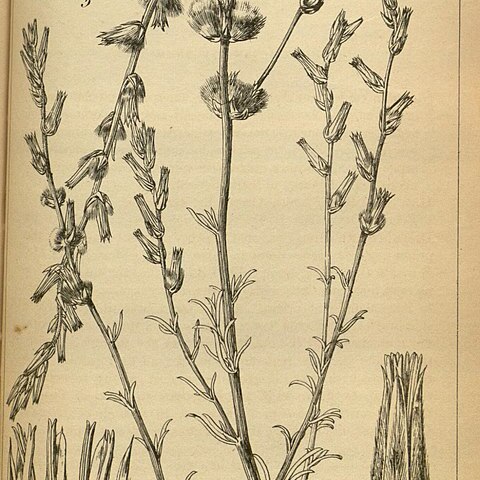Tepals all narrowly lanceolate, tapering from base to apex and straight-sided, of similar length (c. 8–10 mm. long) but the inner progressively narrower, hyaline-margined, the firm portion 3-nerved with the lateral pair of nerves evanescent but the midrib excurrent in a short but sharp and rigid, straight arista, all more or less floccose with frequently longer fine hairs intermixed.
Plant much-branched, rounded and rather bushy, probably a perennial flowering in the first year, 0.4–1 m. tall; stem and branches slender and wiry, terete, young parts green and somewhat floccose to sublanate at least when young (usually soon glabrescent), older cortex brownish-yellow and the base frequently purplish.
Inflorescence much elongating at maturity (up to c. 25 cm. but commonly less), the axis glabrous to floccose; partial inflorescences finally distant (to c. 1 cm. apart), of a single central fertile flower with a modified sterile flower on each side, the lateral brushes of hairs brown to whitish.
Bracteoles of partial inflorescence 4–5 mm. long, deltoid-ovate, finally deeply concave with the midrib bent at c. 90 degrees to accommodate the sterile modified flowers when mature, glabrous to slightly floccose, shortly mucronate with the excurrent midrib.
Leaves linear-acicular, subterete, 6–32 × 0.5–1 mm., mucronate, glabrous or more rarely somewhat floccose, straight or somewhat recurved, usually with axillary short shoots or leaf-fascicles and tufts of floccose hairs.
Stamens c. 6–7 mm. long at anthesis, finally subequalling the perianth, white or pinkish; anthers very long and narrow, c. 4 mm. long, exceeding the filaments at anthesis.
Bracts ovate-lanceolate, 4 –; 5 mm. long, scarious, glabrous and more or less floccose along the green, slightly excurrent midrib, more or less patent after fruit-fall.
Erect herb, up to 1 m high. Leaves linear, 5-15 mm long. Inflorescence with single fertile flowers. Perianth closing after fertilization. Flowers white.
Fruit oblong-ovoid, c. 3.25–3.5 mm. long, densely lanate in the upper half or rather more; seed 3–3.25 mm. in diam., brown, smooth and shining.
Ovary subglobular or obovoid, c. 2.25–2.5 mm. long, with a densely lanate apex.
Fruiting partial inflorescence forming a fluffy ball c. 1.5–2 cm. in diam.
Flowers white to dull yellow or greenish.

